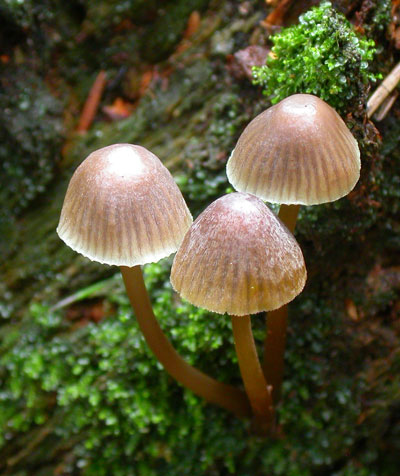Growing on fallen branches or decaying stumps
of coniferous trees. Sometimes also on wood of broad-leaved
trees. Summer to autumn. A rather common species in the boreal zone but very rare in the lowlands with no records from Denmark, a few from the Netherlands and one from the UK (Aronsen & Læssøe 2016). Fairly common in coniferous forest in Norway.
Pileus 10-40
mm across, conical, campanulate, flattening with age, without
or with a low umbo, pruinose, glabrescent, hygrophanous,
sulcate, translucent-striate, reddish brown, olivaceous
brown, greenish brown, olive green, greyish green, the margin
paler, yellowish olive, greenish yellow, or more greenish.
Lamellae 20-25 reaching
the stipe, ascending, narrowly adnate to adnate, occasionally
decurrent with at short tooth, whitish, greyish white, yellowish
white to grey, the edge olivaceous or greenish grey, dark
grey to dark grey-brown, often only near the margin of the
pileus, and sometimes not differently coloured at all.
Stipe 20-70 x
1-3 mm, hollow, fragile, equal or somewhat widened below,
terete, straight to curved, pruinose above, glabrous farther
below, yellowish to yellowish brown (honey-coloured), darker
to dark brown towards the base, the apex sometimes very
pale, almost white, the base densely covered with whitish
fibrils. Odour
indistinctive to weakly nitrous. Taste slightly raphanoid.
Basidia 25-32 x 8-10 µm, slender-clavate,
4-spored, with sterigmata 5-8 µm long. Spores 9-11.8(-13) x 6-7.5 µm, Q 1.3-1.7, Qav ≈ 1.5, broadly pip-shaped, amyloid. Cheilocystidia
23-70 x 7-18(-29) µm, forming a sterile band, clavate,
fusiform, subcylindrical, apically obtuse or mucronate or
narrowed into a simple neck or two necks. Pleurocystidia
not observed. Hyphae
of the pileipellis 2-8 µm wide, not gelatinized, covered
with simple or branched cylindrical to more irregularly
shaped excrescences 2-20 x 1.5-6 µm wich may form dense masses. Hyphae
of the cortical layer of the stipe 1.5-4 µm wide, slightly
gelatinized, smooth or sparsely covered with obtuse warts
or short cylindrical excrescences 1-6(-12) x 2-3.5 µm, terminal
cells with coarse cylindrical to clavate
excrescences. Clamp connections
present at all tissues.
More micro drawings.
Microphotos of cheilocystidia
Microphotos of pileipellis
Microphotos of caulocystidia and stipitipellis
Maas Geesteranus (1988) placed
this species in section Fragilipedes together with Mycena
citrinomarginata, both species formerly
placed in sect. Rubromarginatae. The coloured gill edge indicates
a close relationship to the species of sect. Rubromarginatae,
but in the sense of Maas Geesteranus that section contains
only species with the gill edge coloured pink, reddish
brown or violet. Besides, the edge is not always coloured
or just partly so in M. viridimarginata.
In some collections there are no traces of
different colour at the gill edge, and in some other
collections the colour is visible only very near the margin
of the pileus.
|
|
It is, however, often more visible in younger
specimens. Generally the colour of the lamellar edge is
the same as in the margin of the pileus.
Mycena viridimarginata is a very
variable species. The identification rarely causes any difficulties,
however. The yellowish or honey-coloured stipe combined
with the olive-brown or greenish colours on the pileus are
typical characters.

© A. Aronsen 2004 |